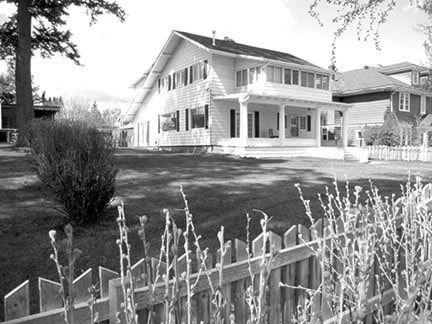Jim Cameron
Mr. E.E. Orchard, having undertaken the construction of, according to the Cranbrook Herald, “one of the finest cottages on Baker Hill” in late 1900, and finding it ready for occupation in the spring of 1901, decided he would pull up stakes and head to Frank, Alberta to open a restaurant. Edward Irwin Paterson, having recently arrived in Cranbrook from Tiverton, Ontario, took the opportunity to purchase the residence.
By 1907, Mr. Paterson found himself secretary-bookkeeper for the Fink Mercantile Company, a rather prestigious position given that the business was among the most prominent in the community. That same year he married Rhoda Leitch.
Daughter of lumber mill owner Archibald Leitch, Rhoda was recently returned from music studies in Toronto and joined Edward in the little bungalow on Garden Avenue. The Leitch family was known throughout the Crowsnest Pass where brother Malcolm built the Leitch Colliery, the ruins of which are still standing today, and where brother Alexander, along with his wife and four sons, perished in the Frank Slide of 1903. Marion Leitch, one of three daughters who miraculously survived, was raised by Rhoda’s family.
 The original Paterson Residence. Built for Mr. E.E. Orchard and completed in March, 1901, it was immediately purchased and occupied by Paterson. – Prospector June, 1911
The original Paterson Residence. Built for Mr. E.E. Orchard and completed in March, 1901, it was immediately purchased and occupied by Paterson. – Prospector June, 1911
In 1912, Edward hired local architect F.S. Rossiter to design a much more prestigious house two blocks south on Garden Avenue. Built by the firm of Baker and Banfield, construction of the handsome two-storey building began in the spring of 1912. Upon completion, Mr. Paterson sold his former residence to Mr. B. McFarlane and he and his wife moved into their large home, eventually filling it with their six children Leitch, Sheila, Douglas, Christine, Bruce and Peter.
In the early morning hours of May 11, 1928, while returning from a basketball game in Kimberley with his children Sheila and Leitch and their friends Colvin McBurney and Dorothy Spence, Mr. Paterson missed a curve and the vehicle overturned. He was crushed beneath the car and died almost instantly. The others escaped with severe bruises. The funeral was held from the family home and he was laid to rest in the Old General Cemetery where he was joined by his wife in March, 1954.
 The original Paterson residence today at 127 -Garden Avenue. – Photo Cameron April, 2016
The original Paterson residence today at 127 -Garden Avenue. – Photo Cameron April, 2016
The Paterson residence, with its distinctive long, sloping roof and columned verandah, came into the possession of Dr. G.E.L. McKinnon in 1929, who remained there until 1972.
* * *
Frank Albert Dunn, born in Maine in 1850, began his railway career at age 15, as a telegrapher with the Wabash Railway. He later became a train dispatcher with the Great Northern Railway at Kalispell, Montana and then with the CPR in Cranbrook. A widower when he arrived in town, he spent much of his free time hunting, fishing and undertaking amateur taxidermy and a brief term as a local alderman.
In 1908, he purchased a number of lots on Hanson Avenue with the intention of having homes built for rental purposes and, between 1909 and 1910, constructed a large residence for himself which he occupied until 1915.
 The Frank Dunn Residence, 216 Hanson Ave. - Prospector Dec. 1913.
The Frank Dunn Residence, 216 Hanson Ave. - Prospector Dec. 1913.
Frank officially retired in 1921, but continued to work for the CPR as a natural resource officer at Wattsburg (Lumberton), Yahk and Canal Flats. He died at age 80, after contracting pneumonia following teeth extraction. His body was sent to Chenoa, Illinois for burial alongside his wife.
As an aside, in 1907, while traveling to Cranbrook on the Great Northern Railway in Montana, his train was infiltrated by robbers Charles MacDonald and George Frankhauser who halted it near Rexford, blew open the mail safe and made off with an estimated $40,000.
Among the last of the Wild West train robberies in North America, Frank stated it was one of the best planned and successful robberies that ever came under his notice but added “he was not anxious to have a repetition of the experience.”
 The Dunn residence today. As with many Cranbrook heritage homes, trees, foliage and fences conspire to obstruct the view. – Cameron Apr. 2016
The Dunn residence today. As with many Cranbrook heritage homes, trees, foliage and fences conspire to obstruct the view. – Cameron Apr. 2016
